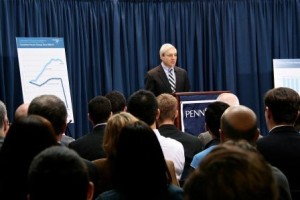
At a press conference Wednesday morning (March 9), Penn State President Graham Spanier said he will do everything in his power to fight the massive, unprecedented cuts in funding for public universities proposed in Pennsylvania Gov. Tom Corbett’s budget unveiled on Tuesday. The governor has proposed a 52.4 percent reduction in Penn State’s appropriation, which represents a decrease of $182 million.
“This is devastating news that could fundamentally change Penn State and our sister institutions in the state and have major negative impacts for the citizens of Pennsylvania and their families,” Spanier said. “Penn State’s appropriation is mostly used to offset the cost of education for Pennsylvania residents, and the direct impact of these cuts would be to undermine the support of in-state tuition for Pennsylvania resident-students. It will undoubtedly push the cost of a Penn State education out of reach for many Pennsylvania families who are already at the maximum level for loans and grants.”
If the proposed budget were to stand, Spanier said the cutbacks would usher in a period of unprecedented change for Penn State and Pennsylvania. While tuition for in-state students would rise more than University administrators had anticipated, he said officials would focus on keeping tuition increases as modest as possible.
“We are very fearful that people around Pennsylvania will be hearing about the governor’s proposal and assuming that we will lay the entire burden of these cuts on our students. We do not intend to do that. We will have to raise tuition, but we do not want to have this impact our students unduly,” Spanier said.
Most of the cutbacks would be felt through program cuts; scaling back of the workforce through attrition and layoffs; salary freezes; further moderation of benefit costs; reduced investment in facilities; the possible closure of campuses; and targeted cutbacks across the University. Spanier said that under this budget scenario “everything is on the table” for consideration.
“There are some things that are very painful for us to think about,” he said. “Layoffs, furloughs and eliminating units — we don’t want any of those things to happen. This is one of the worst times in the history of our country to tell an employee and his or her family that they are now unemployed. That has not been our thinking at Penn State in the past, but this kind of shortfall would put us in that zone.”
Spanier called the proposed cuts a redefinition of Penn State as the Commonwealth’s land-grant institution. The mission of the nation’s public institutions is, in part, to provide higher education at a cost affordable to Americans of average financial means.
“Abraham Lincoln is weeping today,” Spanier said. “He is perhaps looking down on the Commonwealth of Pennsylvania wondering if in a single budget proposal we might undo the legacy he created when he signed the Land Grant Act in 1862, the year Penn State became the first such institution in America.”
Penn State creates more than $17 billion in direct and indirect economic impact in the Commonwealth each year, and Spanier pointed out that Penn State has not contributed to the budget gap faced by Pennsylvania. In fact, during the last decade, the University’s appropriation has remained stagnant while the state’s overall spending has increased by 41 percent. He said the massive cuts proposed by the governor put an undue burden on all of Pennsylvania’s public institutions of higher education.
“We are willing to do our fair share, but this is not our fair share,” said Spanier. “We are hopeful that our message will be heard in Harrisburg, and that they will understand the larger picture we’re talking about here. We hope the members of the legislature, in consultation with the governor, will moderate substantially the scope of this cut.”
The budget includes a $29 million decrease in appropriations for the Penn State College of Agricultural Sciences’ agricultural research program and for Cooperative Extension, a network of services in all Pennsylvania counties that offers practical education and problem-solving assistance based on University research. Spanier said the proposed cuts to agriculture represent a massive challenge and have the potential to fundamentally affect Penn State’s traditional role in support of the state’s top industry. It also will heavily impact the state’s No. 1 industry.
The proposed budget also includes the loss of $13.1 million for Penn State Hershey Medical Center through the elimination of state medical assistance funding and the related loss of federal matching funds, and a $1.4 million cut for Penn College in Williamsport. Spanier said University officials would continue to reach out to legislators as talks on the budget continue.
“We have 24 campuses around the state — almost every legislator has a Penn State campus within driving distance of his or her legislative district. We are, if not the largest, one of a handful of the largest employers in Pennsylvania. We write 47,000 paychecks a month. We have employees in all 67 counties of Pennsylvania. Every member of the Legislature has a stake in Penn State’s budget right now.”
Spanier said University administrators have begun work on contingency plans to address this potentially massive budget shortfall. He said the conversation will be ongoing until state appropriation levels are set with the passage of the state budget, which is anticipated to occur by July 1.
The press conference was broadcast on public television and radio. Nearly 4,000 viewers watched the press conference via a Web link, in addition to nearly two hundred members of the media and audience participants who came in person to Penn State’s Outreach Building on the University Park campus. The University admissions office has been fielding messages of concern from prospective students and their parents, and there has been a continuing flood of supportive e-mail to the University since the conclusion of the press conference.